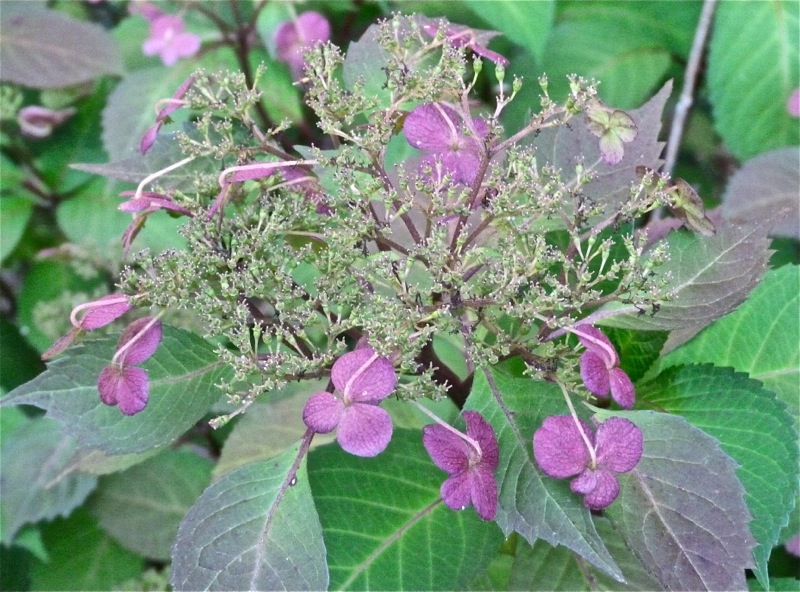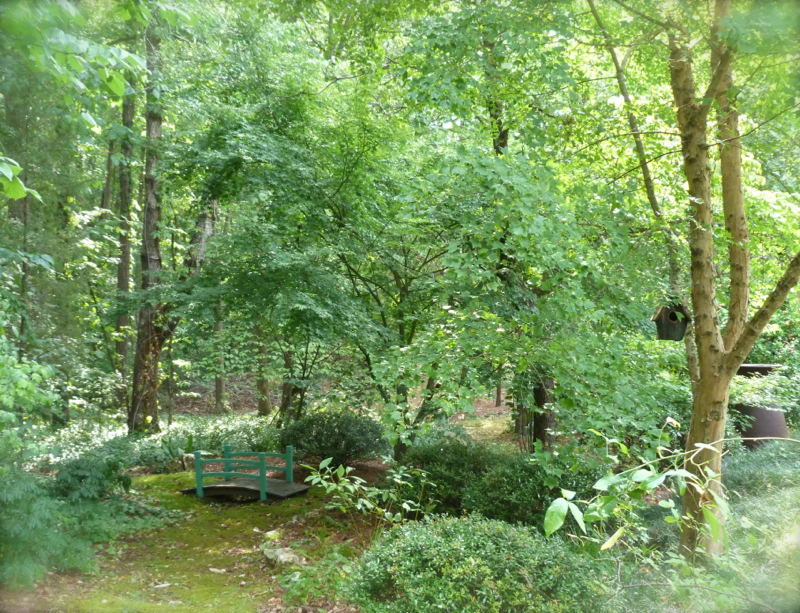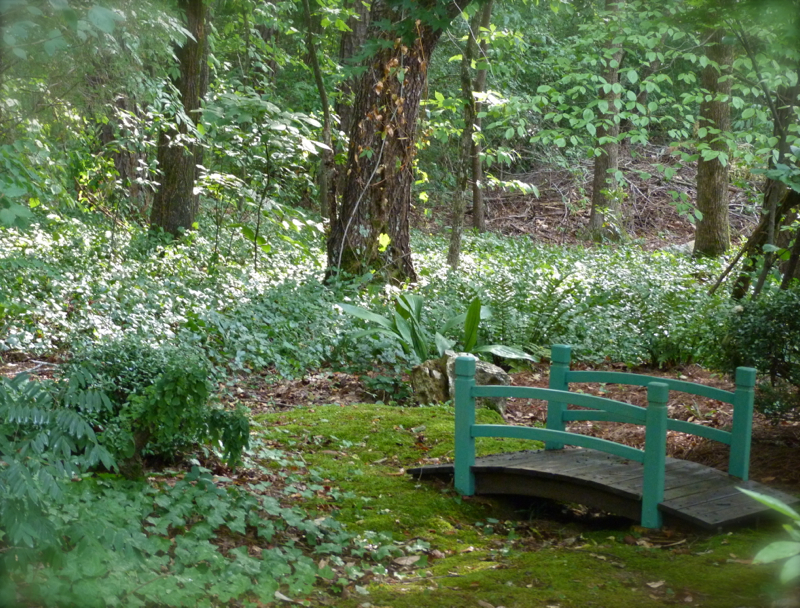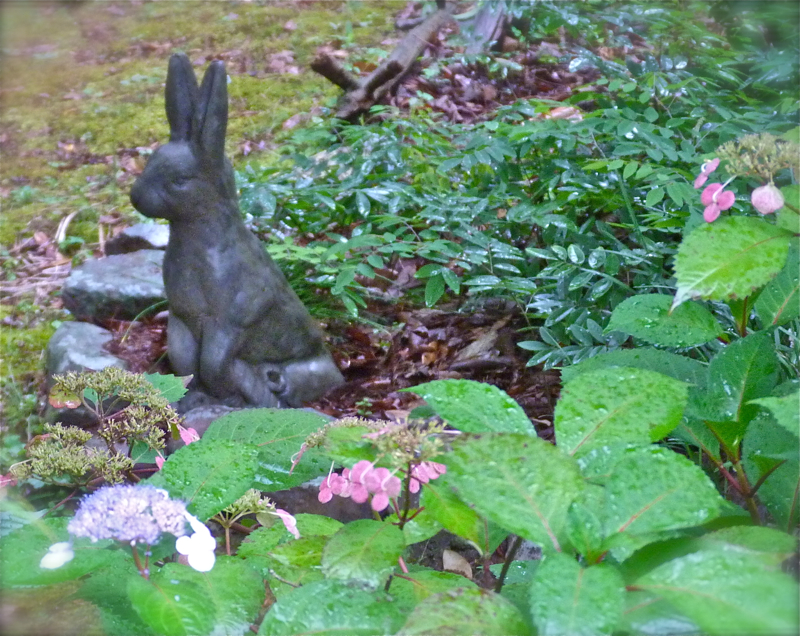How to Combine Plants
 Tuesday, August 14, 2012 at 5:01AM
Tuesday, August 14, 2012 at 5:01AM A recent commenter asked if I would focus on some plant combinations. It is a huge topic, and whole books have been written on the subject. I will mention a few basics to remember, and the rest is as flexible as the gardener's imagination.
First, plant companions that are similarly hardy and have the same light, water, and soil requirements. You can break this rule by planting some things in pots, in which you can alter the hardiness, soil, and water requirements. I have a few tropicals in pots that will come inside for the winter, and I have a couple of potted plants whose soil requirements could not be met in my native soil.
Second, plant in layers. Nature does this, with a canopy of taller trees, an understory of smaller trees and shrubs, then a layer of plants close to the ground. If you plant everything of the same height, the garden will lack dimension, even if the plants are all beautiful.  Above shows a section of the front garden. The different layers with varying textures, shades and forms provide interest, though only crepe myrtles are blooming. The tree in the center is my beloved 'marriage tree', a Japanese maple. Peacock Orchid foliage below it creates a vertical element. Other plants include azaleas, weigela, yaupon hollies, and forsythia.
Above shows a section of the front garden. The different layers with varying textures, shades and forms provide interest, though only crepe myrtles are blooming. The tree in the center is my beloved 'marriage tree', a Japanese maple. Peacock Orchid foliage below it creates a vertical element. Other plants include azaleas, weigela, yaupon hollies, and forsythia.
Above: A trident maple and Japanese maple 'Orido Nishiki' form the top layer in one of my favorite woodland combinations. The middle layer features a smaller tree, Deodar cedar 'Feelin' Blue' and also a Rosa palustris, shown blooming in the foreground in the photo on the left, taken in May. Several yaupon hollies also grow in this area. Mondo grass covers the sloping ground. I like to grow this ground cover on a hillside because it has a natural downward flow.
 Tall pine and oak trees form the canopy over much of the woodland garden. The photo above shows a section of the middle and ground layers. Japanese maple 'Waterfall' arches over spreading yew and frames a bench in the background. On the other side of the moss path is the ground cover Vinca major under some large trees. This is a woodland ground cover and should never be allowed into a flower bed.
Tall pine and oak trees form the canopy over much of the woodland garden. The photo above shows a section of the middle and ground layers. Japanese maple 'Waterfall' arches over spreading yew and frames a bench in the background. On the other side of the moss path is the ground cover Vinca major under some large trees. This is a woodland ground cover and should never be allowed into a flower bed.
 Above is another good understory shrub for the woodland garden, Viburnum dentatum, shown blooming in a springtime photo. I love the hosta 'Elegans' which grows beneath it. Cool blue green is a color that is repeated throughout the woodland garden.
Above is another good understory shrub for the woodland garden, Viburnum dentatum, shown blooming in a springtime photo. I love the hosta 'Elegans' which grows beneath it. Cool blue green is a color that is repeated throughout the woodland garden.
Third, repetition will unify the garden and relate plants to one another. There are several ways to do this:
1. Repetition of the same plant in different areas of the garden will create a flow that pulls the garden together. It is good to have groups of the same plant, unless there is a specimen plant that you wish stand alone. Dwarf Yaupon hollies, shown in the foreground and also seen across the lawn, are low maintenance native shrubs that grow naturally in a rounded form. I use them throughout my gardens to create structure and provide a sense of unity.
Dwarf Yaupon hollies, shown in the foreground and also seen across the lawn, are low maintenance native shrubs that grow naturally in a rounded form. I use them throughout my gardens to create structure and provide a sense of unity.
2. Repetition of color. I like to combine plants where the primary color of one is repeated to a smaller degree in another: Plectranthus and Stromanthe tricolor are beautiful together, though neither are hardy in my area. The stromanthe is in a pot, and I will bring it inside to protect it from winter frost.
Plectranthus and Stromanthe tricolor are beautiful together, though neither are hardy in my area. The stromanthe is in a pot, and I will bring it inside to protect it from winter frost.
While foliage always stars in my garden, I do have some flowers! Below are some color combinations I enjoy. Clockwise from above left: In the front planter are dusty miller, a salmon colored petunia that echoes the color of nearby stonework, and purple blooming heliotrope; In the wildflower garden, orange cosmos reflects airy golden solidago, while garlic chives bloom in between; The colors of a Japanese maple are found in an iris; A bright orange zinnia in a hanging pot repeats the colors of a Tropicanna canna lilly in the background.
Another way to unify with color is to combine plants of the same color, using various shades, shapes, and textures.
Shades of blue repeat in this vignette by the parking court. Blue salvia and silvery artemesia 'Powis Castle' combine well with the little blue cypress growing in a steely blue planter.
 'Waterfall' Japanese maple grows in front of Juniper 'Saybrook Gold', which covers part of a bank in the woodland garden.
'Waterfall' Japanese maple grows in front of Juniper 'Saybrook Gold', which covers part of a bank in the woodland garden.
Even an all green area can be beautiful: Different shades, as well as different forms and texture, provide interest.
Different shades, as well as different forms and texture, provide interest.
3. Repetition of form: This is not in my garden! I took this photo at Biltmore Estate in North Carolina. I love how the weeping form of the Blue Atlas Cedar is echoed by the smaller shrub and in the curve of the path. Even a large tree branch above has a similar arch. Notice also that the bench reflects the color of the cedar.
This is not in my garden! I took this photo at Biltmore Estate in North Carolina. I love how the weeping form of the Blue Atlas Cedar is echoed by the smaller shrub and in the curve of the path. Even a large tree branch above has a similar arch. Notice also that the bench reflects the color of the cedar.
 Above is another view with the 'Waterfall' Japanese maple: I love how the colors of cream, gold and green combine here, as well as how the vertical reach of the heuchera flowers is reflected in the background by liriope and iris foliage.
Above is another view with the 'Waterfall' Japanese maple: I love how the colors of cream, gold and green combine here, as well as how the vertical reach of the heuchera flowers is reflected in the background by liriope and iris foliage.
Finally, introduce an unusual element for a delightful surprise. Who would expect a tropical red banana plant amidst roses, rosemary, and lacy spirea?
I don't think it is out of place, and I love that red banana plant. Remember to plant what makes you smile, and your garden ultimately will reflect your heart and soul. Happy gardening!
By the way, you may be interested in a book, Fine Foliage, which is coming out soon. Written by two professional garden designers, fellow blogger Karen Chapman and Christina Salwitz, it describes foliage combinations and why they work.








